Revisiting "Generating Yield in a Volatile Market"



This article is relevant to financial professionals who are considering offering Model Portfolios to their clients. If you are an individual investor interested in WisdomTree ETF Model Portfolios, please inquire with your financial professional. Not all financial professionals have access to these Model Portfolios.
We last visited the topic of generating yield in an evolving market back in October, and it certainly is time to visit it again. We are sailing through volatile market seas these days, with rates rising, inflation fears mounting and geopolitical tensions as high as they have been in many years. How can investors continue to generate risk-controlled yield in this current environment?
First, let’s look at rates, and let’s start with the Treasury yield curve. While we’ve seen a distinct uptick in recent weeks, real Treasury yields remain negative across the entire maturity spectrum with the exception of the 30-year, which just inched into positive territory.
U.S. Treasury Real Yields (%)
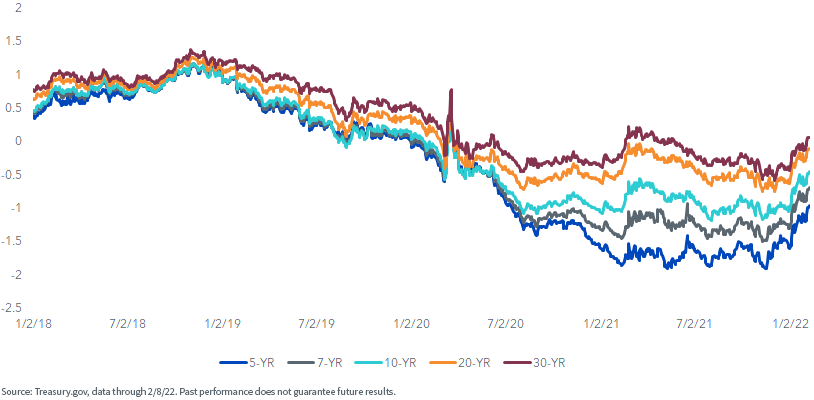
While nominal Treasury rates have been volatile, we’ve seen a distinct upward trend, especially in the short end of the curve, as the market reacts to a decidedly more “hawkish” tone from the Fed. We think, with fits and starts, this upward trend will continue (and note the significant “flattening” of the curve, as measured by the 10-Year minus the 2-Year spread).
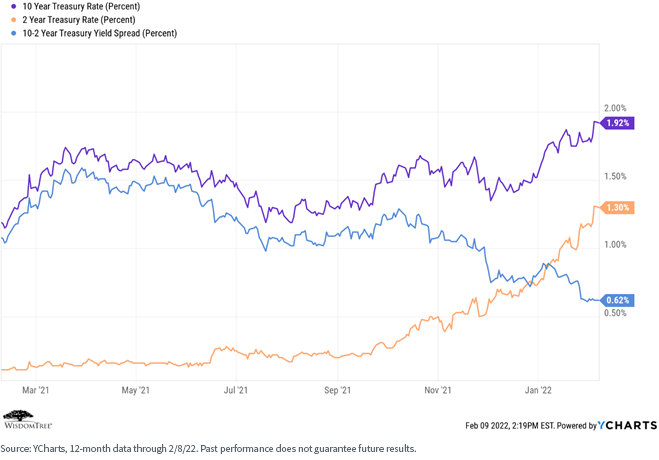
Speaking of the Fed, the market is now pricing in five rate hikes over the course of 2022, and many believe there may be more, resulting in a Fed Funds Rate well above 1.00% by year-end. Furthermore, the market is assuming an almost 100% probability the Fed will initiate rate hikes at its March meeting, and there is open discussion that 50 bps hikes will be on the table over the course of the year. That is a dramatic shift in sentiment and expectations from even 3–4 months ago.
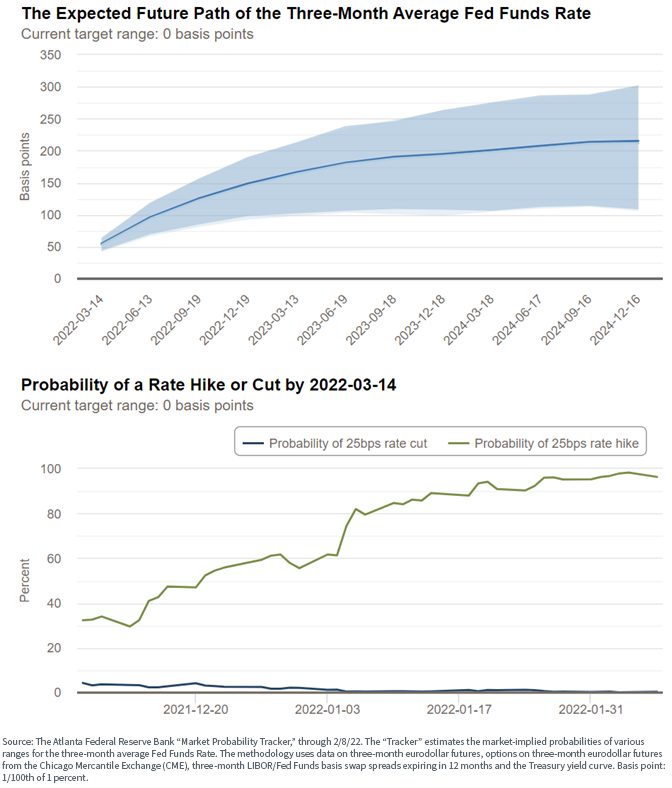
Interestingly, the credit markets largely have yawned through all this recent uncertainty, suggesting that investors remain comfortable with default risk (although you will note the uptick in the most recent days).
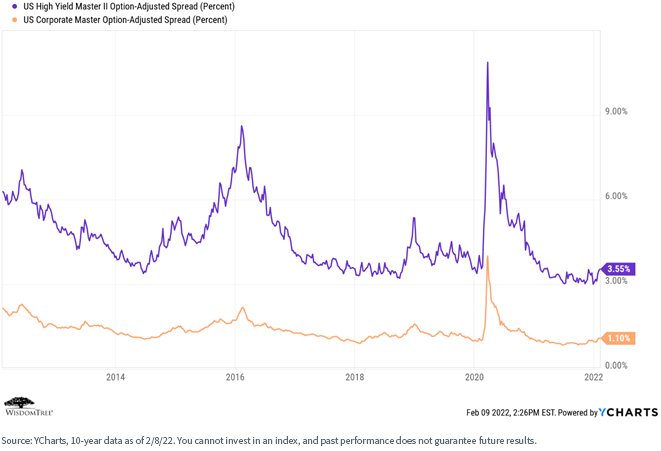
For definitions of terms in the chart, please visit the glossary.
So, What Is a Yield-Seeking Investor to Do?
To summarize the above, we continue to believe that rates will grind higher, and inflation remains the story through at least the first half of 2022. All eyes and ears will be on the Fed as it tries to walk the proverbial tightrope between taming inflation and keeping the economy growing. So, rates are rising, and credit spreads remain tight—not a recipe for a great deal of optimism about risk-controlled total return potential in the fixed income markets.
What about finding yield in the equity markets? Using the information from above, let’s compare current nominal fixed income yields to current equity dividend yields. We see quite a reversal from a year ago, when equity yields were well above fixed income yields.

For definitions of terms in the chart, please visit the glossary.
Investors can now generate a higher level of current income in the bond market than in the equity market (which historically is the more “normal” situation). At the same time, we see increased risk in the fixed income markets and believe that dividends and stock buybacks may represent a more sustainable approach to generating current income.
Our own Model Portfolios remain short in duration and over-weight in credit with an explicit focus on quality security selection relative to the Bloomberg U.S. Aggregate Index (the “Agg”). We definitely are not looking to take excessive risk in our fixed income portfolios in a “reach for yield.”
That said, here are some ideas and solutions that may be of interest.
Fixed Income Strategy Ideas
Obviously, the investment landscape within the fixed income arena is certainly a challenging one. The combination of Fed rate hikes and continued elevated inflation requires a proactive approach to navigate what ultimately lies ahead for the bond investor.
A time-tested approach for a rising rate environment can center around the barbell strategy, where a core bond holding is complemented by a “zero-duration” solution. WisdomTree offers three unique approaches to the “zero-duration” or rate-mitigating strategy portion of the barbell:
- A U.S. government securities-based solution based on floating rate Treasury notes: the WisdomTree Floating Rate Treasury Fund (USFR)
- An investment-grade strategy that combines a long position in bonds representative of the Agg with a short position in Treasury securities to target zero duration: the WisdomTree Interest Rate Hedged U.S. Aggregate Bond Fund (AGZD)
- A “core-plus” approach that combines bonds representative of the WisdomTree U.S. High Yield Corporate Bond Fund and a short position in Treasury securities to target zero duration: the WisdomTree Interest Rate Hedged High Yield Bond Fund (HYZD)
Investors seeking additional yield opportunities may want to consider the WisdomTree Alternative Income Fund (HYIN). HYIN is an alternative credit vehicle that allows investors to “tap” into an asset class to which it has been difficult to gain broad-based exposure. In addition, alternative credit has exhibited less sensitivity to changes in interest rates.
Model Portfolio Ideas
WisdomTree manages three specific Model Portfolios that are yield- and income-oriented—our Siegel-WisdomTree Longevity, Global Dividend and Global Multi-Asset Income Model Portfolios.
These Model Portfolios focus on generating all or the majority of the current yield out of the equity allocations versus the fixed income allocations.
Let’s look at the current yield of these Model Portfolios (as of December 31, 2021).
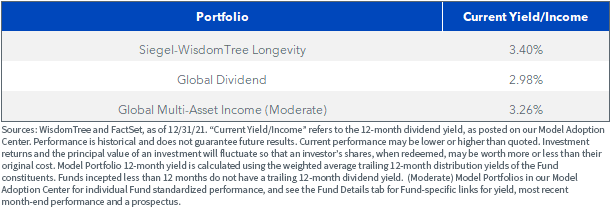
“Current Yield/Income” refers to the most recently posted 12-month dividend yield as indicated here.
For Fund performance, please click the respective Siegel-WisdomTree Longevity, Global Dividend and Global Multi-Asset Income
Now, let’s combine all of this into hypothetical “typical” client portfolios.
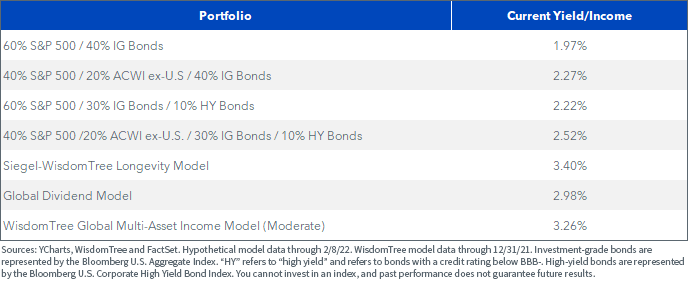
Conclusions
Today’s market environment is fraught with risks for fixed income investors. Despite the pickup in nominal yields, we continue to believe that taking excessive risk in the fixed income market is not a prudent approach. We believe a more appropriate approach is to focus on the global equity markets to generate yield while still maintaining an appropriate fixed income allocation, both for income generation and as a hedge to equity beta risk.
Today’s yield environment is in a state of flux, and things are likely to get more unclear before they get better. But in today’s yield-starved world, we believe you can still build intelligent portfolios that may potentially generate an optimal level of yield without taking excessive risk.
Important Risks Related to this Article
Investors and their advisors should consider the investment objectives, risks, charges and expenses of the funds included in any Model Portfolio carefully before investing. This and other information can be obtained in the Fund’s prospectus by visiting www.wisdomtree.com for WisdomTree Funds. Visit the applicable third-party website for third-party funds. Please read the prospectus carefully before you invest. WisdomTree Asset Management, Inc., does not endorse and is not responsible or liable for any content or other materials made available by other ETF sponsors.
For retail investors: WisdomTree’s Model Portfolios are not intended to constitute investment advice or investment recommendations from WisdomTree. Your investment advisor may or may not implement WisdomTree’s Model Portfolios in your account. The performance of your account may differ from the performance shown for a variety of reasons, including but not limited to: your investment advisor, and not WisdomTree, is responsible for implementing trades in the accounts; differences in market conditions; client-imposed investment restrictions; the timing of client investments and withdrawals; fees payable; and/or other factors. WisdomTree is not responsible for determining the suitability or appropriateness of a strategy based on WisdomTree’s Model Portfolios. WisdomTree does not have investment discretion and does not place trade orders for your account. This material has been created by WisdomTree, and the information included herein has not been verified by your investment advisor and may differ from information provided by your investment advisor. WisdomTree does not undertake to provide impartial investment advice or give advice in a fiduciary capacity. Further, WisdomTree receives revenue in the form of advisory fees for our exchange-traded Funds and management fees for our collective investment trusts.
For financial advisors: WisdomTree Model Portfolio information is designed to be used by financial advisors solely as an educational resource, along with other potential resources advisors may consider, in providing services to their end clients. WisdomTree’s Model Portfolios and related content are for information only and are not intended to provide, and should not be relied on for, tax, legal, accounting, investment or financial planning advice by WisdomTree, nor should any WisdomTree Model Portfolio information be considered or relied upon as investment advice or as a recommendation from WisdomTree, including regarding the use or suitability of any WisdomTree Model Portfolio, any particular security or any particular strategy. In providing WisdomTree Model Portfolio information, WisdomTree is not acting and has not agreed to act in an investment advisory, fiduciary or quasi-fiduciary capacity to any advisor or end client, and has no responsibility in connection therewith, and is not providing individualized investment advice to any advisor or end client, including based on or tailored to the circumstance of any advisor or end client. The Model Portfolio information is provided “as is,” without warranty of any kind, express or implied. WisdomTree is not responsible for determining the securities to be purchased, held and/or sold for any advisor or end client accounts, nor is WisdomTree responsible for determining the suitability or appropriateness of a Model Portfolio or any securities included therein for any third party, including end clients.
Advisors are solely responsible for making investment recommendations and/or decisions with respect to an end client and should consider the end client’s individual financial circumstances, investment time frame, risk tolerance level and investment goals in determining the appropriateness of a particular investment or strategy, without input from WisdomTree. WisdomTree does not have investment discretion and does not place trade orders for any end client accounts. Information and other marketing materials provided to you by WisdomTree concerning a Model Portfolio—including allocations, performance and other characteristics—may not be indicative of an end client’s actual experience from investing in one or more of the funds included in a Model Portfolio. Using an asset allocation strategy does not ensure a profit or protect against loss, and diversification does not eliminate the risk of experiencing investment losses. There is no assurance that investing in accordance with a Model Portfolio’s allocations will provide positive performance over any period. Any content or information included in or related to a WisdomTree Model Portfolio, including descriptions, allocations, data, fund details and disclosures, are subject to change and may not be altered by an advisor or other third party in any way.
WisdomTree primarily uses WisdomTree Funds in the Model Portfolios unless there is no WisdomTree Fund that is consistent with the desired asset allocation or Model Portfolio strategy. As a result, WisdomTree Model Portfolios are expected to include a substantial portion of WisdomTree Funds notwithstanding that there may be a similar fund with a higher rating, lower fees and expenses or substantially better performance. Additionally, WisdomTree and its affiliates will indirectly benefit from investments made based on the Model Portfolios through fees paid by the WisdomTree Funds to WisdomTree and its affiliates for advisory, administrative and other services.
Jeremy Siegel serves as Senior Investment Strategy Advisor to WisdomTree Investments, Inc., and its subsidiary, WisdomTree Asset Management, Inc. (“WTAM” or “WisdomTree”). He serves on the Model Portfolio Investment Committee for the Siegel-WisdomTree Model Portfolios of WisdomTree, which develops and rebalances WisdomTree’s Model Portfolios. In serving as an advisor to WisdomTree in such roles, Mr. Siegel is not attempting to meet the objectives of any person, does not express opinions as to the investment merits of any particular securities and is not undertaking to provide and does not provide any individualized or personalized advice attuned or tailored to the concerns of any person.
The Siegel-WisdomTree Longevity Model Portfolio seeks to address increasing longevity by shifting the focus to potential long-term growth through a higher stock allocation versus more traditional “60/40” portfolios.



